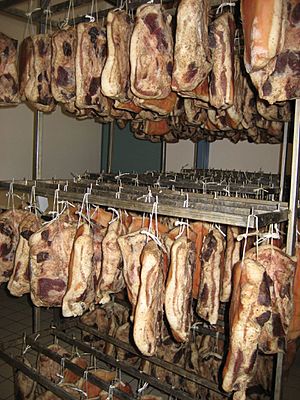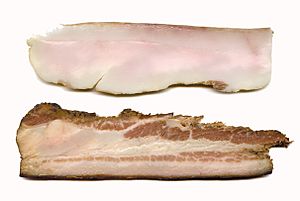Tyrolean Speck facts for kids
Tyrolean Speck is a special kind of ham that comes from the Tyrol region. This historical area is now partly in Italy. What makes Tyrolean Speck unique is its delicious juniper flavor. It's made using a mix of two old ways to preserve food: salt-curing and smoking.
People have been making Tyrolean Speck for a very long time. The first records of it go back to the early 1200s! Today, a type of this ham called Südtiroler Speck has a special "PGI" status. This means its name is protected, and it can only be called that if it's made in a specific way in that region.
Contents
How Tyrolean Speck is Made
Tyrolean Speck is made from the back leg of a pig, just like other famous hams such as prosciutto. Before it's cured, the bone is taken out.
Preparing the Pork
First, a pig's leg is carefully deboned. Then, it's cut into large pieces. These pieces are called "baffe." Next, the meat is cured using salt and a special mix of spices. These spices often include garlic, bay leaves, juniper berries, and nutmeg. After the spices are added, the meat rests for several weeks. This resting time helps the flavors soak in.
Smoking and Aging
After curing, the meat is cold-smoked. This is done slowly, for only a few hours each day over about a week. Woods like beech are used for smoking. The temperature is kept very low, never going above 20°C (68°F). This slow, cool smoking gives the speck its special taste. After smoking, the speck is left to mature for about five months. This long aging process helps it develop its full flavor and texture.
Ways to Enjoy Tyrolean Speck
Tyrolean Speck is very versatile and can be eaten in many ways. It's a popular food in the region where it's made.
Serving Ideas
You can enjoy Tyrolean Speck sliced very thinly. It often tastes great with horseradish, pickles, and dark rye bread. It's also commonly served with hearty, whole-grain breads. Sometimes, chefs wrap thin slices of speck around scallops or breadsticks. It can even be served with lobster salad!
Cooking with Speck
Tyrolean Speck can be cut into thicker strips and added to pasta sauces. It's also great in dishes that start with a mix of olive oil and chopped vegetables, like a soffritto. Because its flavor is very strong, it pairs well with lighter tastes. For example, in risotto, you can balance the speck with parsley, lemon, or mint. In salads, it goes well with apples, sprouts, mushrooms, and celery. In Italy, speck is often used as a topping for pizza or mixed into pasta and risotto.
Speck vs. Bacon
Tyrolean Speck can easily be used instead of bacon or as a smoky choice instead of Pancetta. The main differences between Tyrolean Speck and bacon are how long they are smoked, the curing methods, and that speck cures for a much longer time than bacon does.
fr:Speck dell' Alto Adige it:Speck dell'Alto Adige IGP pt:Speck



